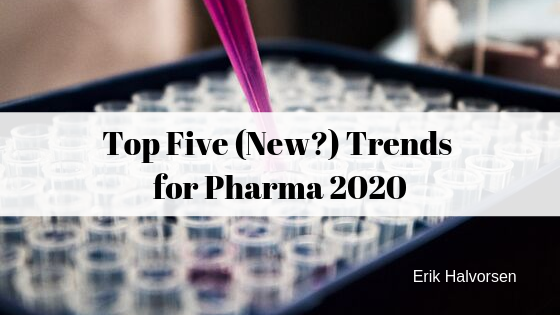The pharmaceutical industry is growing at a steadily rising rate. It is expected to be worth about $1.1 trillion by 2021. There are over 2000 compounds in late stage clinical development and over 200 new products projected to be approved in the next couple years—a level of production that has not been seen in over a decade. There are a number of key trends within the pharmaceutical industry that are familiar and still driving the field like rising healthcare costs, the need for lower cost drugs, heavy focus on oncology and significant M&A activity and collaborations to fill pipelines. But there are a few newer trends that will be interesting to watch and see what their long-term impact on the pharma industry will be.
Advances in Artificial Intelligence
Artificial intelligence (AI) quickly became a buzzword that every wannabe entrepreneur worked into the pitch for their new app. “This dog walking app uses AI to match the emotional IQ of the walker to the temperament of the breed to ensure the strongest bond.” All jokes aside, AI continues to play an increasing role in speeding up drug discoveries and improving the efficiency of the selection, testing and IND enabling studies. The role of AI is expected to grow into new areas for pharma including matching and recruiting patients to clinical trials, improving medication adherence and detecting medication abuse. The future of AI for the pharma industry is here to stay but companies will have to sort through the noise of all these upstart AI companies and apps.
Exploitation of Medical Marijuana’s Potential
The perceived potential of medical marijuana and the broad cannabidiol (CBD) medication industry is expected to gain more acceptance in the U.S. and countries that had previously restricted its use. Already approved for medical use in 33 states and a number of states recreationally that number is only expected to creep upwards. With the first cannabidiol medication, Epidiolex, having been released in 2018, pharmaceutical companies are expected to expedite research and development on progressive usages of the drug and other CBD-based drugs. With patients already seeking out access to medical (or recreational) marijuana to reduce pain, help with sleep and ameliorate side effects of chemotherapy—medical marijuana poses both an opportunity and a threat to pharma company pipelines.
Proliferation of Blockchain
The application of blockchain technology, first developed for the financial industry, is expected to increasingly find its way into the pharmaceutical industry. Pharmaceutical companies are expected to integrate their data through the crypto-concept, thereby enabling faster data sharing and data processing across the organization. It will also allow for increased transparency and secure transactions of data with key strategic partners like hospitals, payers and government regulators. This should allow the pharmaceutical sector to achieve increased operational efficiency, saving time and cutting on costs on R&D. I wonder if they will pass the savings along to us?
Cost Regulations and Value Based Approvals
As the healthcare sector receives much emphasis and attention from governments across the globe, including the US and EU, cost is going to become one of the key areas of focus. The governments in various countries are expected to play an active role in helping regulate the cost of medication to help bring down the overall cost of acquisition of medical services. Huge discrepancies in costs to consumers for the same drug depending on whether it is bought in Canada, the US or EU are generating a lot of valid concerns about cost and access that must be addressed.
Value-based medication approval is rapidly becoming a reality as new medicines must not only show improved outcomes but cost effectiveness as well. If a new drug is only marginally better than a generic, it will find a hard time getting approval, gaining market share and maintaining a premium price point that newly approved drugs have been used to. The emergence of exciting gene therapy and gene editing treatments will come with a VERY high price tag. How much leverage will insurers and consumers have to make sure these treatments are reasonably priced?
Regenerative Medicine and Stem Cell Therapy
Remember when there was a difference between “biotech” and “pharma”? Biotechnology companies worked on large molecules like proteins and antibodies and pharma worked on small molecules or what we commonly think of as drugs. Now, there is no distinction. Through mergers and expanding R&D pipelines and capabilities, most of the big pharma companies have therapeutics across a variety of modalities. With the recent exception of Vertex’s acquisition of Semma Therapeutics, the one area most pharma have yet to venture into is the stem cell and regenerative medicine space. Ever since the discovery of embryonic stem cells in the early 2000’s and then the so-called “adult stem cells” and progenitor cells that we possess in all of our tissues with the potential to regenerate and differentiate into new healthy tissue, the promise of “regenerative medicine” and using our own body to heal itself has been exciting.
There have been major scientific advances in the field in the last decade and clinical success as well, but pharma seems less than eager to embrace it. Is it because it threatens their billion dollar pipelines of drugs or are they waiting on more clinical validation? At least one company is betting a billion dollars that using stem cells to treat diabetes is going to be more effective than anything we have seen to date. Will other pharma follow and collaborate with or snap up these regenerative medicine companies?
These are a few of the trends in the pharma industry for 2020 from where I sit—what are you seeing?
Erik Halvorsen is the Chief Business & Strategy Officer at FAR Biotech. As a result of his industry experience, Erik is an often sought-after public speaker, and he has served as an advisor to various hospitals and start-ups. He is constantly looking for new ways to improve patients’ lives while changing the broader healthcare industry for the better. He has been referred to as a “translator,” in that he has the ability to speak science with businesspeople and speak business with science people.

